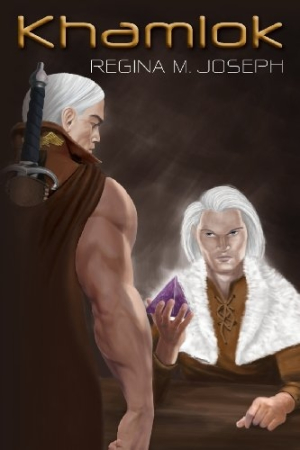Khamlok
Pagan rituals and herbal medicine team up with laser beams and space travel in Khamlok, the second installment in Regina M. Joseph’s Alterran Legacy series. With Colony Earth in 2012, Joseph began to explore an alternate history of Earth initiated by an alien-human merger. Now, with the provocative story of Khamlok, she imagines the society such a fusion might have created and the challenges its members could face.
Basing her story on ancient Sumerian myths that told of alien intervention on Earth in prehistoric times, Joseph chronicles the joining of Earthkeeper Alana of Earth with Supreme Ruler Lil from the planet Alterra. A comet strike has stranded Lil and his people on Earth with no way home, and Alana’s clan faces enemies both mortal (the violence of the neighboring Danes) and climatological (the threat of catastrophic flooding). Both born leaders, Alana and Lil mean to use their union to save their respective populations and perhaps create something stronger.
Joseph covers colonization themes familiar to any science fiction and fantasy reader. How much should the colonizing species interfere with its host’s development? Lil, for instance, has successfully used mencomm, a type of technological telepathy, as a leader on Alterra. Should he introduce this technology to humans who are just discovering agriculture? Though countless novels have explored the problem of humans interfering with civilizations on foreign planets, the city of Khamlok is being built on Earth. With this shift in focus, Joseph brings the dilemma closer to home.
Khamlok is populated with a wide range of characters, which also adds to the story’s realism. Alana and Lil head up the new hybrid clan, and they both utilize their own special gifts. Alana can harness the spirits of the earth, while Lil uses technology to read the thoughts of others. Although these heroes sometimes suffer from seeming too perfect, the author provides an array of supporting characters to fill out the cast. Particularly interesting is Lil’s right-hand man, Azazel, a warrior whose skills are redirected to the training of hunters in this new, peaceful society. Lil doesn’t want Azazel to develop an army in his utopia, but Azazel thinks it might be wise. Lil is never sure if Azazel is with him or against him, and neither are readers, which makes for a fascinating series of events as Khamlok’s walls are breached by outsiders.
Also delightful are Lil’s mother, Uras, who proves that mothers-in-law can be difficult no matter what planet they are from, and a shaman, Yoachim, who is equal parts fool and wise man. Joseph’s attention to everyday accomplishments—raising children, harvesting the wheat crop, trading deer hides, building huts, and so forth—creates a very believable world for her characters to inhabit.
Joseph tells her story clearly, maintaining several threads that don’t come together until very near the end. To keep the complicated plot lines afloat, however, she often uses dialogue as exposition, which slows the pace significantly. Characters exchange long spiels of background information, and while the content always adds something to the tale, it doesn’t always sound like real-life conversation.
Khamlok feels like the middle-of-the-series book it is, a space authors commonly use to develop characters, explain events, and set up future action. Indeed, the story ends on an intriguing cliffhanger that suggests that human-Alterran interactions will look quite different in future volumes.
Reviewed by
Sheila M. Trask
Disclosure: This article is not an endorsement, but a review. The publisher of this book provided free copies of the book and paid a small fee to have their book reviewed by a professional reviewer. Foreword Reviews and Clarion Reviews make no guarantee that the publisher will receive a positive review. Foreword Magazine, Inc. is disclosing this in accordance with the Federal Trade Commission’s 16 CFR, Part 255.

